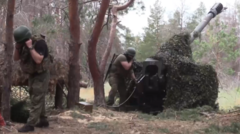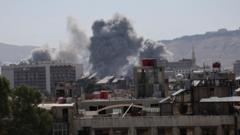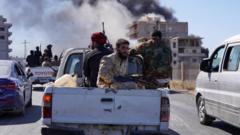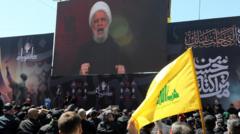As Russia seeks territorial gains in Ukraine by targeting multiple fronts, Ukrainian resilience presents significant challenges, thwarting Moscow's ambitions and leading to high casualties on both sides.
Russia Intensifies Military Operations in Ukraine Amidst Staunch Resistance

Russia Intensifies Military Operations in Ukraine Amidst Staunch Resistance
In an escalating conflict, Russia attempts to establish new fronts in Ukraine while facing fierce opposition from Ukrainian forces.
The conflict in Ukraine has reached a pivotal moment as Russia launches intensified military operations aimed at expanding its territorial control. Overnight drone and missile assaults have surged, yet the progress on the ground remains met with staunch Ukrainian resistance. In July, Russian forces reportedly secured 556 square kilometers (215 square miles)—their most substantial land acquisition this year, underscoring the significant scale of these military efforts.
The current objectives for Russia include severing Ukrainian supply routes in the eastern regions while establishing a buffer zone along its own border—specifically targeting the northeastern Sumy region, and the strategic cities of Pokrovsk and Kostyantynivka in eastern Ukraine. Despite this apparent momentum, the advance has stalled; if these gains were to continue at the current rate, experts suggest that full territorial control could take decades.
In a bid to thin out Ukrainian military resources along the 1,200-km front line, Russia has concentrated around 111,000 troops near the city of Pokrovsk, which has been a focal point of contention for over two years. However, traditional large-scale assaults are scarce. Instead, Russian military tactics have shifted towards a "creeping offensive," utilizing small infantry groups that gradually weaken Ukrainian positions. This ongoing method of warfare has resulted in significant Russian casualties, with assertions of over 1,000 daily losses.
Ukrainian forces continue to defend vital territories, notably the city of Kostyantynivka, while Russian strategies seem to revolve around encircling Ukrainian units in these regions. Observers note that although some areas are experiencing rapid movements, the overall thrust of the Russian military appears politically motivated rather than strategically sound.
Despite incursions into regions like Dnipropetrovsk and claims of territorial gains, Ukrainian military officials refute such assertions as overstated. The battlefields are increasingly dangerous, with drone warfare becoming a primary method for Russia to disrupt Ukrainian supply chains. Commenting on the dire logistics, Ukrainian forces express difficulty in transporting essential supplies, exacerbated by ongoing drone threats aimed not only at soldiers but also at civilians to instill fear.
As the realities of this conflict continue to unfold, both military strategists and civilians brace for an uncertain future shaped by shifting offensives and enduring resistance.
The current objectives for Russia include severing Ukrainian supply routes in the eastern regions while establishing a buffer zone along its own border—specifically targeting the northeastern Sumy region, and the strategic cities of Pokrovsk and Kostyantynivka in eastern Ukraine. Despite this apparent momentum, the advance has stalled; if these gains were to continue at the current rate, experts suggest that full territorial control could take decades.
In a bid to thin out Ukrainian military resources along the 1,200-km front line, Russia has concentrated around 111,000 troops near the city of Pokrovsk, which has been a focal point of contention for over two years. However, traditional large-scale assaults are scarce. Instead, Russian military tactics have shifted towards a "creeping offensive," utilizing small infantry groups that gradually weaken Ukrainian positions. This ongoing method of warfare has resulted in significant Russian casualties, with assertions of over 1,000 daily losses.
Ukrainian forces continue to defend vital territories, notably the city of Kostyantynivka, while Russian strategies seem to revolve around encircling Ukrainian units in these regions. Observers note that although some areas are experiencing rapid movements, the overall thrust of the Russian military appears politically motivated rather than strategically sound.
Despite incursions into regions like Dnipropetrovsk and claims of territorial gains, Ukrainian military officials refute such assertions as overstated. The battlefields are increasingly dangerous, with drone warfare becoming a primary method for Russia to disrupt Ukrainian supply chains. Commenting on the dire logistics, Ukrainian forces express difficulty in transporting essential supplies, exacerbated by ongoing drone threats aimed not only at soldiers but also at civilians to instill fear.
As the realities of this conflict continue to unfold, both military strategists and civilians brace for an uncertain future shaped by shifting offensives and enduring resistance.






















